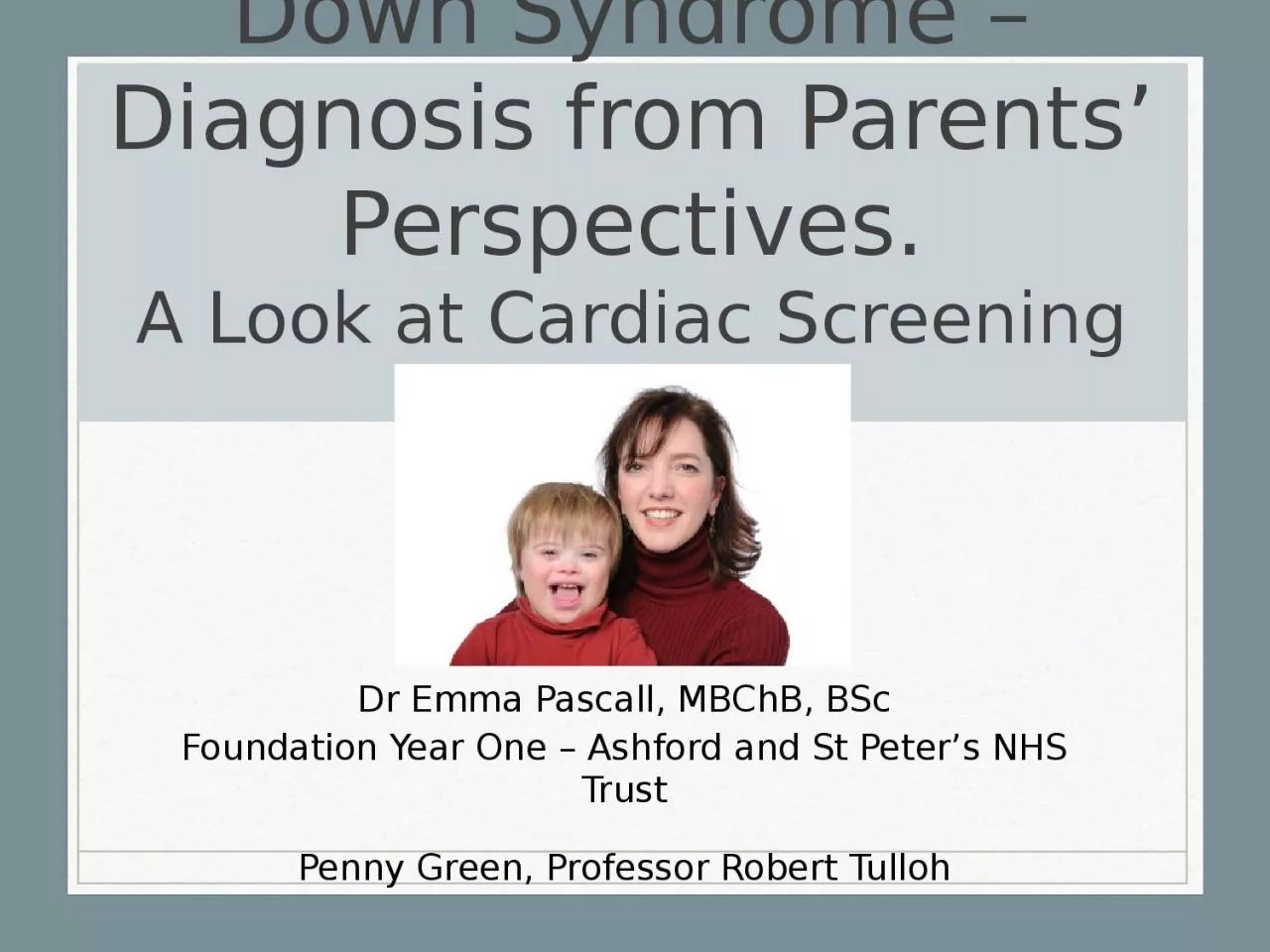

from Parents Perspectives A Look at Cardiac S creening Dr Emma Pascall MBChB BSc Foundation Year One Ashford and St Peters NHS Trust Penny Green Professor Robert ID: 1041643
Download Presentation The PPT/PDF document "Down Syndrome – Diagnosis" is the property of its rightful owner. Permission is granted to download and print the materials on this web site for personal, non-commercial use only, and to display it on your personal computer provided you do not modify the materials and that you retain all copyright notices contained in the materials. By downloading content from our website, you accept the terms of this agreement.
1. Down Syndrome – Diagnosis from Parents’ Perspectives.A Look at Cardiac ScreeningDr Emma Pascall, MBChB, BScFoundation Year One – Ashford and St Peter’s NHS TrustPenny Green, Professor Robert Tulloh
2. What this talk will includeIntroductionCurrent guidelinesSurveyIndicationMethodologyResultsDiscussionLimitationsFuture suggestions
3. Introduction40 to 60% of patients have congenital heart defects130-40% of these are atrioventricular septal defects (AVSDs) 1,2,3Early diagnosis and treatment helps to prevent the complication of pulmonary vascular disease (PVD) 4,5,6,7,8Some severe congenital heart disease still presents too late 3Irreversible PVD more likely to develop quickly in children with Down’s syndrome and AVSD 7,8,9Ideally surgery before 6 months, some studies say 4 months
4. Guidelines45.1 Babies diagnosed with Down’s syndrome in the early neonatal period:Shortly after diagnosis clinical examination and ECGAbnormal clinical signs or ECG abnormality (particuarly a QRS axis) - referred and seen within 2 weeks of birth by a paediatric cardiologist and for an echocardiogramIf no abnormalities – referred and seen within 6 weeks of birth by a paediatric cardiologist and for an echocardiogram5.2 Babies diagnosed later in the neonatal period:Immediate ECG and clinical examination and accelerated referral to paediatric cardiologist so they achieve the above 6 week deadline5.3 Babies with a prenatal diagnosis of Down’s syndrome – in the absence of evidence of sensitivity of fetal echocardiography, still follow the early neonatal pathway(5.4 Older children who have never had an echocardiogram:No symptoms or clinical signs and normal ECG – routine referral to paediatric cardiologist.Symptomatic and / or have abnormal clinical signs or ECG – referral urgently to paediatric cardiologist
5. When was the baby diagnosed with Down Syndrome?Early in the neonatal period or prenatal diagnosisAbnormal clinical signs or ECG abnormality Clinical examination and ECGImmediate clinical examination and ECGLater in the neonatal periodAccelerated referral so seen within 6 weeks No abnormalitiesReferred and seen within 6 weeksReferred and seen with 2 weeks
6. SurveyAimed to review if parents thought these standards were met in their children with Down syndrome Indication?Parents were invited to complete a survey relating to the diagnosis of Down syndrome and any cardiac manifestations Shared on the Down Syndrome Heart Group and Facebook
7. Results137 responses16% diagnosed antenatally75% diagnosed within one week of birth8% diagnosed after 1 week(1% - did not answer)
8. The time of diagnosis of Down syndrome in all responders
9. Results71% of babies were reported to have a cardiac anomaly25% of these were AVSDs
10.
11. ResultsAntenatal diagnosis - 32% had immediate ECG and examination.All of these met the 2 and 6 week guidelineDiagnosed within 1 week - 66% had an ECG and examinationThis group largely met the referral guidelines (70% and 96% for 2 and 6 weeks respectively)Diagnosed after 1 week - 91% had immediate ECG and examination80% seen within 6 weeks
12. DiscussionAkin to other research, the majority of patients had a AVSDMost diagnosed postnatallyGuidelines largely being met but some areas for improvementFor antenatal diagnoses, only 32% of responders reported having an immediate ECG and clinical examinationHowever, 45.4% of responders either were unsure or did not answerIs this due to parental understanding?All met the guidelines for follow up so suggests this
13. DiscussionDiagnosed early in the neonatal period:Slight improvement in the number with clinical examinations and ECGsStill, one fifth reported to have notMost meet the 6 week deadline = 96%Fewer meet the 2 weeks deadline = 70%
14. DiscussionDiagnosed later in the neonatal period:Mostly met the guidelinesImmediate exmaination and ECG = 91%Seen within 6 weeks = 80%Majority of the responders fell into this category
15. LimitationsQualitativeRetrospectiveFocused study sampleParental perception – uncertainty
16. Future suggestionsEducationLeaflets?Publicising the website more?Timeline of what should happen?Specialist nurses
17. Any questions?
18. References1 Frid C, Drott P, Lundell B, Rasmussen F, Anneren G. Mortality in Down's syndrome in relation to congenital malformations. J Intellect Disabil Res 1999; 43(Pt 3):234-41.2 Torfs CP, Christianson RE. Anomalies in Down syndrome individuals in a large population- based registry. Am J Med Genet 1998; 77(5):431-8.3 Tubman TR, Shields MD, Craig BG, Mulholland HC, Nevin NC. Congenital heart disease in Down's syndrome: two year prospective early screening study. BMJ 1991; 302(6790):1425-7.4 Down Syndrome Medical Interest Group. Basic Medical Surveillance Essentials For People With Down’s Syndrome. Cardiac Disease: Congenital and Acquired. Revised 2007. http://www.dsmig.org.uk/library/articles/guideline-cardiac-5.pdf. (accessed July 2007).